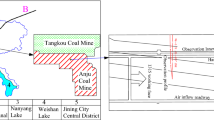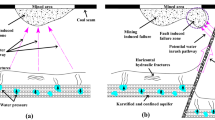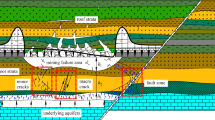Abstract
Water inrush due to fault activation in deep coal mining is the main type of water disaster in central and eastern China. This paper analyzed the primary form and mechanism of fault activation that triggers water inrush and derived the critical conditions for fault activation. The WuGou coal mine is used as a geological example, and the characteristics of the fault activation and mechanism of the confined water rising were researched by similar simulation experiments. The results provide the following conclusions. (1) There are three forms of fault activation that trigger water inrush: continuous fault, hidden fault and associated fault activation. (2) Mining causes high abutment pressure in a coal seam; this pressure transfers to the floor, causing damage and failure. The maximum failure depth occurs when the overlying strata is in a critical fractured state. The cracks of the floor gradually close in the goaf. (3) The fault activation causes water inrush and exhibits four stages: fault zone yielding caused by high stress, cracking and extending of the fault zone, movement and slippage of the fault zone, and confined water rising. (4) The influence factors of the confined water rising were analyzed. The experimental results show a negative correlation between the confined water height and distance to the fault zone and a positive correlation among the confined water pressure, fault zone width and confined water height. In addition, a strong–weak–strong change law of the confined water pressure with height is observed.
















Similar content being viewed by others
References
Chen ZH, Hu ZP, Li H et al (2011) Fracture mechanical model and criteria of insidious fault water inrush in coal mines. J China Univ Min Tech 40(5):673–677
Gui H, Lin M (2016) Types of water hazards in China coal mines and regional characteristics. Nat Hazards 84:1501–1512
Han J, Shi LQ, Yu XG et al (2009) Mechanism of mine water inrush through a fault from the floor. Min Sci Technol 19:276–281
Huang QX (2007) Experimental research of overburden movement and subsurface water seeping in shallow seam mining. J Univ Sci Technol Beijing Miner Metall Mater (Eng Ed) 14(6):483–489
Li HM, Fu K (2006) Some major technical problems and counter measures for deep mining. J Min Saf Eng 23(4):468–471
Li LC, Tang CA, Liang ZZ et al (2009) Numerical analysis of pathway formation of ground water inrush from faults in coal seam floor. China J Rock Mech Eng 28(2):290–297
Li LC, Yang TH, Liang ZZ et al (2011) Numerical investigation of groundwater outbursts near faults in underground coal mines. In J Coal Geol 85:276–288
Liu WT, Wu Q (2008) Numerical simulations of water inrush of fault F0 in Fangezhuang coal mine. Chin J Rock Mech Eng 27(Supp. 2):3604–3610
Lu Y, Wang L (2015) Numerical simulation of mining-induced fracture evolution and water flow in coal seam floor above a confined aquifer. Comput Geotech 67:157–171
Lu HF, Shen D, Yao DX et al (2014) Analytical solution of critical water inrush pressure of mining floor affected by fault. J Min Saf Eng 31(6):888–895
Miao XX, Cui XM, Wang JA et al (2011) The height of fractured water-conducting zone in undermined rock strata. Eng Geol 120:32–39
Peng JB, Chen LW, Huang QB et al (2013) Physical simulation of surface fissures triggered by undersurface fault activity. Eng Geol 155(2):19–30
Qiao W, Hu G, Li WP (2013) Experimental study on the conversion from seepage to flow of water inrush aroused by fault activation in fully mechanized top-coal caving. J Min Saf Eng 30(1):30–37
Shi BQ, Hou ZJ (2011) Mechanical analysis of fault activation water inrush in over burden rock and its application. Rock Soil Mech 32(10):3053–3057
Shi LQ, Xin HQ, Zhai PH et al (2012) Calculating the height of water flowing fracture zone in deep mining. J China Univ Min Technol 41(1):37–41
Song ZQ, Hao J, Tang JQ et al (2013) Study on water inrush from fault’s prevention and control theory. J China Coal Soc 38(9):1511–1515
Sun J, Wang LG (2013) Floor fault water-inrush prediction based on catastrophe analysis of micro-seismic signals. J China Coal Soc 38(8):1404–1410
Sun W, Zhou W, Jiao J (2015) Hydro-geological classification and water inrush accidents in China’s coal mines. Mine Water Environ 35:214–220
Tang J, Bai H, Bang HY et al (2011) Theoretical analysis on water-inrush mechanism of concealed collapse pillars in floor. Min Sci Technol 21:57–60
Wang C, Zhang N, Han Y et al (2015) Experiment research on overburden mining-induced fracture evolution and its fractal characteristics in ascending mining. Arab J Geosci 8(1):13–21
Wang W, Jiang T, Faybishenko B et al (2016) Closure of fracture due to cover stress re-establishment after coal mining. Geotech Geol Eng 34:1525–1537
Wu Q, Wang M, Wu X (2004) Investigations of groundwater bursting into coal mine seam floors from fault zones. Int J Min Sci Technol 41:557–571
Yin S, Zhang J, Liu D (2015) A study of mine water inrushes by measurements of in situ stress and rock failures. Nat Hazards 79:1961–1979
Yuan R, Li Y, Jiao Z (2015) Movement of overburden stratum and damage evolution of floor stratum during coal mining above aquifers. Proc Eng 102:1857–1866
Zhang H, Cao J, Tu M (2013) Floor stress evolution laws and its effect on stability of floor roadway. Int J Min Sci Technol 23:631–636
Zhang PS, Yan W, Zhang WQ et al (2016) Mechanism of water inrush due to damage of floor and fault activation induced by mining coal seam with fault defects under fluid-solid coupling mode. Chin J Geotech Eng 38(5):877–889
Zhu WB, Wang XZ, Kong X et al (2009) Study of mechanism of stope water inrush caused by water accumulation in over-burden separation areas. Chin J Rock Mech Eng 28(2):306–311
Zhu GL, Zhang WQ, Zhang GB et al (2017) Experimental research on fault activation conducting water inrush. Rock Soi Mech 38(11):3163–3172
Acknowledgements
This research was supported by the National Natural Science Foundation of China (41472281 and 51379119).
Author information
Authors and Affiliations
Corresponding author
Rights and permissions
About this article
Cite this article
Zhu, G., Zhang, W., Wang, S. et al. Experimental Research on Characteristics of Fault Activation and Confined Water Rising. Geotech Geol Eng 36, 2625–2636 (2018). https://doi.org/10.1007/s10706-018-0487-x
Received:
Accepted:
Published:
Issue Date:
DOI: https://doi.org/10.1007/s10706-018-0487-x




